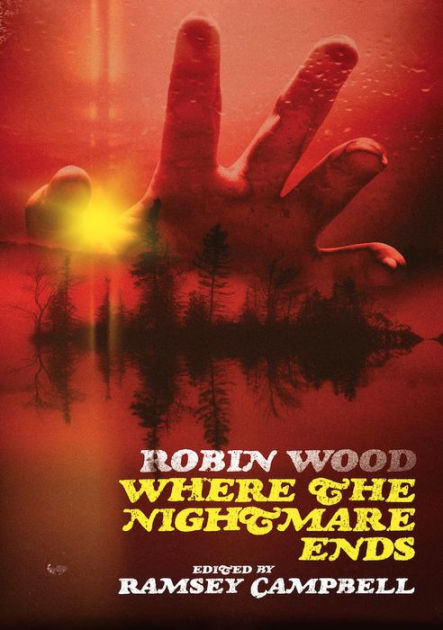 By ROBIN WOOD (PS Publishing; 2023)
By ROBIN WOOD (PS Publishing; 2023)
A posthumously published novel that, like most such publications, falls short of greatness. WHERE THE NIGHTMARE ENDS was written many years ago by Canada’s late Robin Wood (1931-2009), a film critic and longtime horror enthusiast (as demonstrated by the classic monograph THE AMERICAN NIGHTMARE) who initially conceived the novel as a screenplay—as is evident in descriptions like “If you had been watching this as a scene in a film, you might have assumed it was a period piece.”
The text was pieced together in 2022 by Ramsey Campbell, who in an afterward name checks H.P. Lovecraft and Vladimir Nabokov, as Wood’s writing “would clarify and expand my view of cinema as powerfully as those writers developed my sense of the possibilities of prose.” Campbell also suggests that WHERE THE NIGHTMARE ENDS may have been the inspiration for the 1982 splatter fest HUMONGOUS (although I’ve been unable to find any documentation supporting that claim), which brings up one of several problems I have with the novel: its story isn’t particularly original, being redolent not just of HUMONGOUS but also Larry Cohen’s IT’S ALIVE (Wood was a massive Cohen adherent) and FRIDAY THE 13th.
The latter is evoked in the set-up, involving a group of sexually precocious—and uniformly vile—young people on a wilderness sojourn near the Ontario-based “Island of Love.” This refers to a secluded island haven purchased a year earlier by a middle-aged British couple, evoked in a prologue in which the couple settle into a house on the island and discuss birthing a child. The baby, it’s believed, was born dead, with its elders dying under circumstances that remain obscure.
Among the sojourn’s participants are an infant named Sally and an elderly couple, who wisely elect to ditch their fellows prior to a boat trip to the Island of Love, “the perfect picnic place, but without a picnic.” But the boat crashes on the rocks bordering the island, stranding the group in the British couple’s now-deserted house.
If this novel has any real interest, it’s in its sly subversion of standard horror movie tropes (about which Robin Wood was more knowledgeable than virtually anyone). Based on how the early portions of the book are developed, with character and dialogue being at the forefront, it would appear the protagonists are in for horror of the quiet variety—a Lovecraftian curse, perhaps, or an unexplained Dennis Etchisonian supernatural presence.
Yet what transpires isn’t “quiet” at all, with a monstrous baby (the one that was supposed to be dead) emerging from the house’s cellar to lay waste to everything and everyone in its path. This causes one of the protagonists, a sexually impulsive young woman who in standard horror movie parlance would be one of the first characters to get killed, becoming the group’s unlikely leader, while a male character, in a development that probably seemed quite shocking when this story was initially conceived, is revealed to be gay (nowadays the shock is that in a novel by Robin Wood, who reportedly claimed there was a gay subtext to be found in every Hollywood movie ever made, there’s only one example).
An especially memorable bit occurs near the end, in which Sally disappears. She would appear to be dead, but turns up in a strikingly horrific yet appropriate situation that’s pulled off with an impeccable sense of macabre timing (and would have made for an excellent horror movie moment).
For the most part, though, we’re continually reminded why this novel went unpublished during its author’s lifetime. The characters are uniformly off-putting, the dialogue bland and the narrative hopelessly contrived (if there’s any plausible reason for an infant to be included in the action I have yet to find it). With more practice Mr. Wood might have become a skilled novelist, but when he wrote WHERE THE NIGHTMARE ENDS he clearly hadn’t reached that point.
